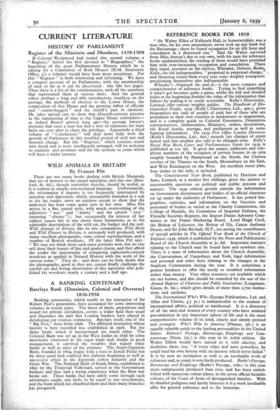REFERENCE BOOKS FOR 1939
" Sir Walter Elliot of Kellynch Hall, in Somersetshire, was a man who, for his own amusement, never took up any book but the Baronetage ; there he found occupation for an idle hour and consolation is a distressed one." Had Sir Walter survived from Miss Austen's day to our own, with his taste for reference books undiminished, the reading of them would have provided him with ever-increasing occupation and consolation. There they stand, renewed on the shelves, Whitaker, Debrett, Burke, Kelly, the old indispensables, " perpetual in perpetual change," and thrusting round them every year come weighty youngsters proclaiming themselves also indispensable. Whitaker's Aimanack (6s. and 3s.) is the most compact and comprehensive of reference books. Trying to find something it hasn't got becomes quite a game, whilst the full and detailed index at the beginning doubles the value of the information that follows by making it so easily accessible. Kelly's Directories, Limited, offer various weighty guides. The Handbook of Dis- tinguished People, 1939 (Kelly's Directories, Ltd., 4os.), gives biographies not only of people of rank but of those who are prominent in their own counties as landowners or magistrates, and is a complete guide to Colonial Governors, Dominions representatives, Ambassadors, Ministers, orders, decorations, the Royal family, peerage, and parliament as well as some hunting information. The 1939 Post Office London Directory (Kelly's Directories, Ltd., 6os.) records 75o changes of street names and lists another 300 odd to be changed soon. Kelly's Royal Blue Book, Court and Parliamentary Guide for 1939 is published at los. 6d. It gives the names, addresses and tele- phone numbers of the occupiers of private houses in an area roughly bounded by Hampstead on the North, the Chelsea reaches of the Thames on the South, Bloomsbury on the East, and West Kensington on the West. An excellent street plan, four inches to the mile, is included.
The Constitutional Year Book, published by Harrison and Sons, Limited, at a modest five shillings, gives the answer to innumerable questions on political and public persons and matters. The 1939 edition greatly extends the information on Government departments and bodies of an official character set up under the authority of Parliament. It has potted bio- graphies, statistics, and information on the function, and personnel of bodies as varied as the Charity Commission, the College of Heralds, the Committee of Imperial Defence, the Friendly Societies Registry, the Import Duties Advisory Com- mittee or the Potato Marketing Board. Lord Hugh Cecil, • the Bishop of Leicester, the Bishop of Ely, Canon Anthony Deane, and Sir John Birchall, M.P., are among the contributors of special articles in The Official Year Book of the Church of England, 1939, which is published by the Press and Publications "; Board of the Church Assembly at 3s. 6d. Important statistics relating to the Church may be found here and nowhere else. There is a mass of information about the Church Assembly, the Convocations of Canterbury and York, legal information and personal and other facts relating to the changes in the Anglican Communion during the year. It is sometimes a greater kindness to offer the needy or troubled information rather than money. Very often resources arc available which are not known, and this should be remedied by the use of the Annual Register of Charities and Public Institutions (Longmans, • Green, 8s. 6d.), which gives details of more than 2,7oo institu- tions and societies.
The International Who's Who (Europa Publications, Ltd. and Allen and Unwin, £3 3s.) is indispensable to the student of international affairs, political or intellectual. It is a directory of all the men and women of every country who have attained pre-eminence in any important sphere of life and is the most comprehensive volume of its kind, clearly and simply printed and arranged. Who's Who in America (Pitman, 36s.) is an equally valuable guide to the leading personalities in the United States. Debrett's Peerage, Baronetage, Knightage and Com- pcmicmage (Dean, 75s.) is this year in its 226th edition. Sir Walter Elliott would have turned to it with alacrity, and doubtless there, too, " if every other- leaf were powerless, he could read his own history with an interest which never failed." It is by now an institution as well as an invaluable work of reference and, as usual, is very finely produCed. Buike's Peerage, Baronetage and Knightage (Burke's Peerage, 126s.) is this year more sumptuously produced than ever, and has been embel- lished with numerous colour plates, in the seven official heraldic colours, of the Coats of Arms of distinguished families. With its detailed pedigrees and family histories it is a work invaluable alike for general reference and to the historian.










































 Previous page
Previous page